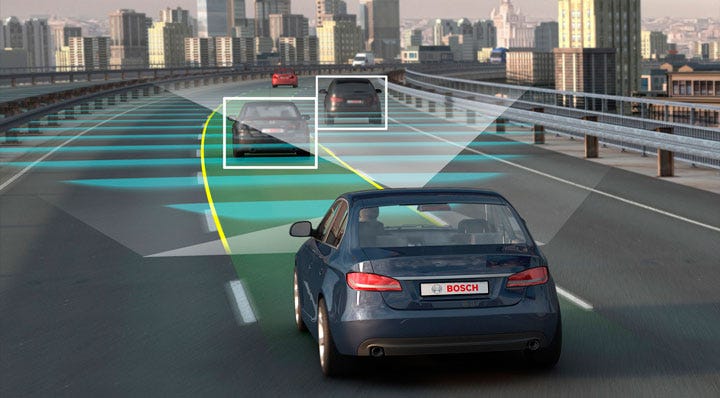This project aims to clone a driving style of a person into a self-driving car on a simulation track using deep learning, as can be seen on the following two animations:
Refer the Self Driving Car Notebook for complete Information
- Design an autonomous car (AC),a vehicle that is adept at sensing its surroundings and navigating without human involvement and aim at training a model which would enable a car to run autonomously using behavioral cloning technique and convolutional neural network.
- Used convolutional neural networks (CNNs) to map the raw pixels from a front-facing camera to the steering commands for a self-driving car. This powerful end-to-end approach means that with minimum training data from humans, the system learns to steer, with or without lane markings, on both local roads and highways. The system can also operate in areas with unclear visual guidance such as parking lots or unpaved roads.
- The system is trained to automatically learn the internal representations of necessary processing steps, such as detecting useful road features, with only the human steering angle as the training signal. We do not need to explicitly trained it to detect, for example, the outline of roads.
- First we normalized input layer producing normalized input plane. Convolution layer which used 24 filtersalong with 5X5 kernel. 2 nd Convolution layer which used 36 filters along with 5X5 kernel. 3 rd Convolution layer which used 48 filters along with 5X5 kernel. 4 th Convolution layerwhich uses 64 filters along with 5X5 kernel. We needed to flatten our data to 1D shape of 1152 (18X64). Final step is output node we use mean square error as error metric.We use elu activation function inspite of relu activation function.
- When a node in neural network dies (give –ve value) relu activation function feed a value 0 to the node that follow it.In our model back propogation uses gradient value to change the weight value of the nodes. Since gradient value is zero then weight of the node never change. This means node always receive a negative input and always feed forward the value of zero without learning. If enough value dies then loss of model will remain stagnant & never decrease. But elu gives non zero gradient value in –ve region.It has chance to recover & fix its weight parameter to decrease its error .It always remain capable of learning and continuity to the model.
- Process of creating new data image uses existing dataset. It is done by applying transformation to current set of image which results in brand new set of image increasing variety. Provide more variety and these customization augmentation techniquescan be combined to add variety to dataset.
- Zooming :-Zooming allow our model to get closer look at some of feature in image andimprove feature extraction. Affine deals explicitly with affine type transformations thatpreserve straight lines and plane with the object.
- Pan- Horizontal and vertical transformation of image. Affine deals explicitly with affine type transformations that preserve straight lines and plane with the object.
- Altering brightness :-Mutiplies all image inside the image with a specific value. If value less than 1 - darker . If value more than 1 - brighter .
- Flipping :- Randomly flip image which help to balance our dataset. We applied horizontal flip.
The training itself takes random batch of images from all three cameras and their corresponding steering values:
Both left and right camera images adjust the steering angle value a bit - the assumption is that when the front camera sees an image similar to our training left/right image, its steering angle must be corrected as it would otherwise run into the risk of escaping the road. This however causes a tricky situation where car might be driving from left to right and back on straights due to this enforced steering intervention. From the experience, this tends to get better with more training epochs.
Car running on known track
Car running on Unknown track
(1) Udacity: https://medium.com/udacity/open-sourcing-223gb-of-mountain-view-driving-data-f6b5593fbfa5
70 minutes of data ~ 223GB
Format: Image, latitude, longitude, gear, brake, throttle, steering angles and speed
(2) Udacity Dataset: https://github.com/udacity/self-driving-car/tree/master/datasets [Datsets ranging from 40 to 183 GB in different conditions]
- A small amount of training data from less than a hundred hours of driving was sufficient to train the car to operate in diverse conditions, on highways, local and residential roads in sunny, cloudy, and rainy conditions.
- The CNN is able to learn meaningful road features from a very sparse training signal (steering alone).
- More work is needed to improve the robustness of the network, to find methods to verify the robustness, and to improve visualization of the network-internal processing steps.
-
It would be great to train model with speed, acceleration, gyroscope details etc. Also, driving a real car in the world outside and using the footage instead of simulator. However, as photorealistic rendering is getting widespread, it might be sufficient to use some new simulator as well.
-
Results of this project could be also applied to real world, e.g. building an own Jetson-based racecar like the Racecar from MIT, collect training data by driving it around, use home supercomputer to train Dave-2 network and then let it drive autonomously and observe what could be improved.
-
Another interesting idea would be to extend this model to 3D for controlling a drone, for example a delivery drone that can have its flights restricted to a well-known area and where a smaller neural network is sufficient.
(1) https://github.com/SullyChen/Autopilot-TensorFlow
(2) Research paper: End to End Learning for Self-Driving Cars by Nvidia. [https://arxiv.org/pdf/1604.07316.pdf]
(3) Nvidia blog: https://devblogs.nvidia.com/deep-learning-self-driving-cars/
(4) https://devblogs.nvidia.com/explaining-deep-learning-self-driving-car/


